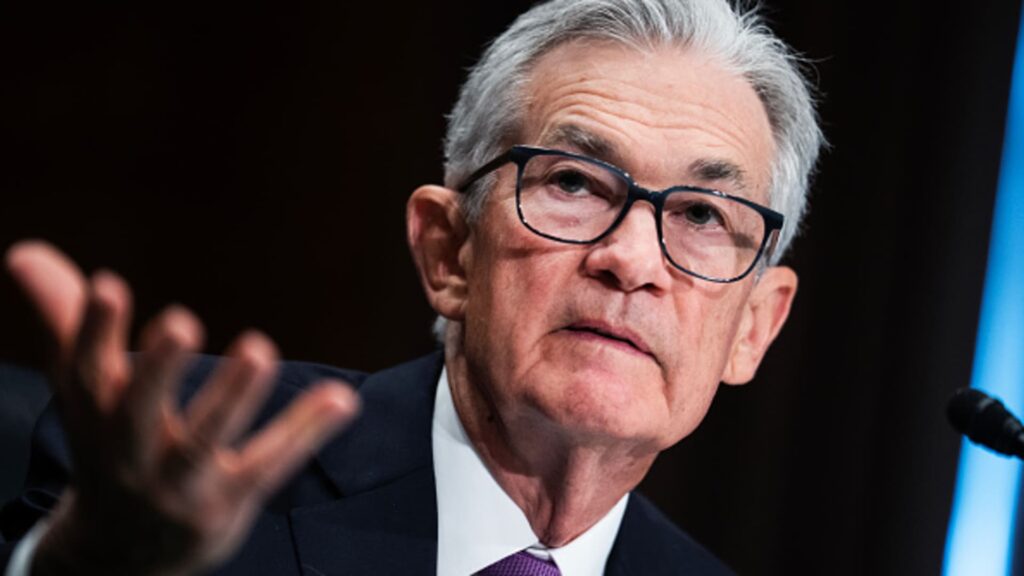
UNITED STATES – MARCH 7: Federal Reserve Chairman Jerome Powell testifies during the Senate Banking, Housing and Urban Affairs Committee hearing titled “The Semiannual Monetary Policy Report to the Congress,” in Dirksen Building on Thursday, March 7, 2024. (Tom Williams/CQ-Roll Call, Inc via Getty Images)
Tom Williams | Cq-roll Call, Inc. | Getty Images
Forecasters in the CNBC Fed Survey are increasingly confident that the U.S. economy will avoid recession and pull off a soft landing and, unlike past surveys, don’t even see growth slowing much below potential in the next couple of years.
But the possible downside of the better forecast: less Fed easing with the possibility that officials at their meeting this week forecast fewer rate cuts in 2024 they did in December.
“For now, the narrative that the U.S. economy is so fragile that it cannot survive without ultra-low rates has been debunked and discarded into the rubbish bin of history,” wrote John Donaldson, director of fixed income at the Haverford Trust Co., in response to the survey.
The March survey finds the average probability of a soft landing at 52%, up from 47% in the January survey and the first time that it’s been above 50% since the question was first asked in July. The probability of a recession in the next 12 months fell to 32%, the lowest since February 2022, and down from 39% in January and 63% in November.
“The U.S. economy continues to move toward a modest growth and modest inflation environment,” said Scott Wren, senior global market strategist at the Wells Fargo Investment Institute. “This may take longer than initial expectations, but the trend is favorable.”
The Fed’s two-day meeting ends on Wednesday where the central bank is largely expected to keep the federal funds target rate at a range of 5.25% to 5.5%. The CNBC Fed Survey respondents include economists, strategists and fund managers.
Forecasters in general have a bad track record of predicting recessions. The 27 respondents to this survey, who include economists, strategists and fund managers, joined other forecasters in the past year in being a fairly certain a recession would hit in 2023. That turned out not to be the case. And while the average recession probability is down, about 20% of respondents still say there’s an even money chance or greater of a downturn in the next 12 months.
“The larger-than-consensus reduction in the federal funds rate in my forecast is contingent on a recession that brings inflation down,” said Robert Fry, of Robert Fry Economics. He has a 60% recession probability and sees the Fed slashing rates to 3.6% by year end from the current level of 5.38%.
Rate cut forecasts
Respondents still see three cuts this year, on average, which would bring the funds rate down to 4.6%. Survey respondents never became as euphoric as futures markets about rate cuts and so haven’t had to backtrack from the six cuts that the markets priced in. Even then, there are those who believe the Fed could be more hawkish at the upcoming meeting.
Guy LeBas, chief fixed income strategist a Janney Montgomery Scott, said, “The last two months of slightly elevated inflation readings have slammed the door on a rate cut at the moment…There is a high probability the dot plot will include 2 rate cuts in 2024…”
In December, the last time the Fed released its official forecasts, members called for three cuts this year.
Half of respondents believe the biggest risk is that the Fed cuts too late while 46% worry the Fed will cut too early. But continued high inflation is judged to be the biggest risk to the economic expansion.
Respondents are a bit more optimistic about rate cuts next year, with the average funds rate forecast to decline to 3.6% compared with a 3.9% forecast in September.
One notable feature of the forecast is call for a very modest economic slowdown. GDP is predicted to grow 1.6% this year, down from 2.5% last year, but far above the 0.7% forecast for 2024 made back in July. The 1.6% is just barely below what is judged to be potential growth and the economy is seen rising just barely above that level to around 2% in 2025. While not a boom, it’s also not nearly as much of a slowdown as has been routinely predicted for the year ahead.
The March forecast marks the third straight increase in the 2024 outlook. Now, GDP is not seen below 1% in any of the next four quarters, something that had been a persistent feature of the more pessimistic forecasts of the past year.
Inflation forecast
With more growth, comes only modest inflation reduction this year. The Consumer Price Index is forecast to fall to 2.7%, down from the current level of 3.2%. It’s seen falling to 2.4% next year, about equal to the Fed’s 2% target for the PCE Price Index, because CPI is believed to run about a half point above PCE.
The unemployment rate ticks up to 4.2%, from 3.9% now, but stays there through 2025. Mark Zandi, Chief Economist, Moody’s Analytics writes, “The Federal Reserve has all but achieved its goals of full employment …and low and stable inflation… The Fed should declare victory and begin to slowly cut short-term interest rates and wind down its QT.”
The balance sheet runoff, or QT, is now forecast to end in January, compared with November in the prior survey. The Fed is seen reducing its total reserves by about a trillion dollars to $6.7 trillion before quitting quantitative tightening and letting bank reserves decline to $2.9 trillion, from the current level of $3.6 trillion.
One-third of respondents say the bigger risk is the Fed stopping too early and leaving its balance sheet too large, 19% are worried about the Fed stopping the runoff too late, but a 37% plurality say neither is much of a risk.
While a soft landing has for the first time become the bet of a majority in the survey, 58% also believe equities may be “somewhat overpriced” for that scenario. As a result, respondents see only muted gains in the S&P of 1.8% this year and 5.8% next year from the current level. Those returns are not far off or even better than what investors could receive by buying risk-free one or two-year treasury notes, offering a persistent challenge to equities from bonds if rates remain high. The 10-year is expected to remain around 4% for this year and next.
Economist Hugh Johnson believes markets have come too far, too fast and sees “a somewhat more difficult equity market environment in 2024…before beginning a recovery to the upside…”
Other see a challenge to equity markets directly from the Fed: “The Fed is in no hurry to cut rates,” wrote Richard Sichel, senior investment strategist at The Philadelphia Trust Company. “Current interest rates are more normal than they have been in fifteen years. A diversified high quality stock portfolio should continue to provide good returns.”






